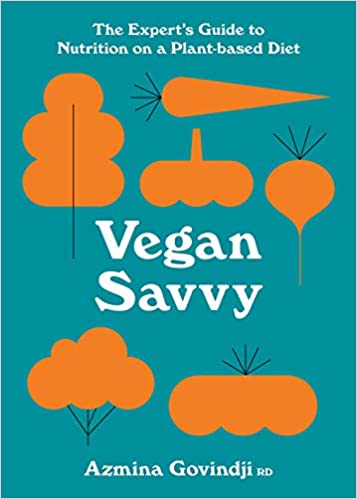What To Do If Veganuary Has Left You Hungry All The Time
We speak to dietitian Azmina Govindji for advice on how to get the vegan diet right

More people are doing Veganuary in 2021 than ever before, and while veganism is an ethical stance, many may have been influenced by the promise of following a healthier diet for the first 30 days of the year. Except, of course, going vegan doesn’t automatically result in a healthier diet – in fact, done poorly it can leave you short on nutrients (just like a poorly planned omnivore diet can).
The new book Vegan Savvy: The Expert’s Guide To Nutrition On A Plant-Based Diet by dietitian Azmina Govindji doesn’t try to convert anyone to veganism, but gives practical advice to help any vegan (or dabbler) eat well. We spoke to Govindji about her experiences following a vegan diet when writing the book and what a nutrient bridge is.
You tried following a vegan diet for eight weeks. What did you learn?
You have to plan. I thought with all the knowledge that I’ve got, it would be quite easy for me just to swap foods and still eat well. But what I noticed was, if I didn't plan well then I wasn’t going to get to the range of nutrients I thought I could get.
Mainly, I was eating lovely whole plant foods, but it’s difficult sometimes to eat enough – to get all the calories and nutrients you need.
I also found that I needed to spend more time cooking, because I noticed that some convenience foods were very high in salt or didn’t have enough of certain nutrients.
In my experience, you can’t decide to become vegan overnight and get it right. I think what is needed is careful planning, a great shopping list, time to cook and a bit of awareness around how you plate up your meals.
Have you got any tips for making sure you eat enough and don’t feel hungry constantly on a vegan diet?
Look for foods that are more filling. We know from research that those foods are the foods that are high in protein and that are high in fibre. A lot of people doing Veganuary tend to forget that. So they’ll have beautiful colourful soups and salads, and roasted aubergines and all sorts of delicious foods, but they haven't thought about the protein that will help them to be satiated for longer.
Sign up for workout ideas, training advice, reviews of the latest gear and more.
That’s where that VVPC plate [dividing every plate of food into quarters filled with vegetables, vegetables, protein and carbs] comes in. My daughter and her friends, they think about that VVPC plate and go, right, I've got my roasted veg here and I've got my crusty bread for the carbs, then they'll throw on some cashew nuts. I didn't think about the protein. And it's the protein in those cashew nuts that will help you to stay fuller for longer.
Where do you think vegan diets can go wrong and become unhealthy?
When you change from an animal-based diet to a completely plant-based diet, you need to be aware that some of the nutrients within your foods may be less available to the body for use, and therefore these can be nutrients of concern.
There are some key nutrients like vitamin B12 which generally you will only get in animal-based foods like meat. And there are other key nutrients that are less talked about, like iodine, which you get from fish, eggs and dairy products, mainly – you can get them in vegetarian foods, but not quite so much.
The other thing to remember is that even if, for example, there’s calcium in spinach, there are also substances called oxalates in spinach that can reduce your absorption of the calcium. The calcium is less bioavailable, which means it's less able to be used by the body. With an animal-based diet, there are other factors that improve calcium absorption – dairy foods in your diet helps improve absorption of nutrients. That doesn't mean you shouldn’t eat spinach, or you should think you’re not getting your calcium from spinach. It’s making you aware so that you eat more, so that the amount that you get from that portion is enough for your body.
A similar example, which I use in the book, is comparing steak with spinach in terms of iron. There is 2.6mg of iron in 100g of cooked beef and in 100g of cooked spinach. So the same amount of food, same amount of iron, but because of absorption differences, you only get a small amount of that iron from spinach.
In your book you use the concept of “nutrient bridges”. Are these essentially tips and tricks to address these areas where the vegan diet can leave you short of nutrients?
It’s exactly that, because I found that there were so many nutrient gaps that I needed to find a creative way for people to make up for the shortfall in a practical sense.
The nutrient bridges, like putting lemon juice on hummus, are very small changes. Will they really make a noticeable difference?
Once is not going to make a great difference to your iron levels. But over the course of a week, if you are adopting a few of the nutrient bridges for different micronutrients, then you are far more likely to get enough of the nutrients that are less available.
It’s about choosing the bridges that work for you and your lifestyle, and making those into habits. So whenever you’re cooking, shove in some nutritional yeast and you can’t go wrong. Whenever you’re thickening a stew or a curry, throw in some peanut butter or tahini paste.
Over time, taking on small changes like adding lemon juice to hummus can be quite significant. If you did that every time you ate beans or hummus, you would be improving your iron status. So yes, one bridge isn’t going to make a significant difference, but it’s about creating these small changes in habit.
Have you got a favourite nutrient bridge that you find yourself using all the time?
I quite like throwing sesame seeds into everything, because they’re a good source of calcium and they're really versatile. Calcium is needed for bones and teeth and for other other reactions in the body so we need to make sure we're getting enough calcium, especially older people or teenage girls whose bones are developing.
You can throw sesame seeds into broccoli or a stir fry, or use them as a coating for homemade mock fish fingers. If you’re vegan you could put them on toast. Sesame seed paste, which is tahini, is great for giving foods a creamy texture with a calcium, protein and fibre hit.
See related
- The Vegan Diet: What You Need To Know
- The Best Sources Of Protein For Vegans
- The Best Vegan Recipe Box And Meal Delivery Services
If you get the vegan diet right, what benefits can it have?
The evidence is still growing, but there are so many things we know about the change to plant-based eating. Assuming you’ve got all the nutrients you need on a well-designed vegan diet – and that’s a really important assumption – then you can have all the nutritional and health benefits.
Simply by increasing the number of plant-based foods in your diet, you're going to increase your fibre intake, which is great for your gut and digestive health.
Then there is research to suggest that people who are vegetarians and vegans – again, who do it right – have a lower BMI. There are lots of diet-related conditions, like type 2 diabetes and cardiovascular disease, that are based on your metabolic health and your BMI can influence your metabolic health.
I've had patients with diabetes tell me that when they’ve changed to a plant-based diet, their blood glucose control has improved. That’s great for long-term management of diabetes.
I've also had people say to me that they’ve got more energy, because when you’re having a plant-based diet, you’re more likely to get your five portions of fruit and vegetables a day. And a lot of these nutrients in fruits and veggies do help to reduce tiredness and fatigue.
Vegan Savvy: The Expert’s Guide To Nutrition On A Plant-based Diet is published by Pavilion Books, RRP £12.99

Vegan Savvy: The expert's guide to nutrition on a plant-based diet

Jonathan Shannon was the editor of the Coach website from 2016 to 2024, developing a wide-ranging experience of health and fitness. Jonathan took up running while editing Coach and used the training plans on the site to run a sub-40min 10K, 1hr 28min half marathon and 3hr 6min marathon. He’s an advocate of cycling to work and is Coach’s e-bike reviewer, and not just because he lives up a bit of a hill. He also reviews fitness trackers and other workout gear.
